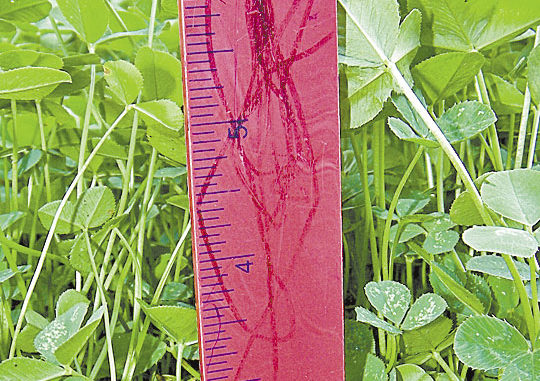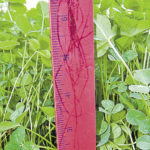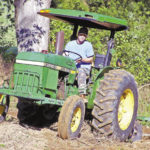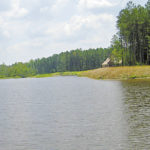
November means business for the majority of deer hunters. With the rut peaking and cool weather settling in, few hunters consider food-plot management or improvement something to schedule this month as they focus on maximizing their time in the deer stand. But choice food plots need attention after heavy activity and browsing this month, with clover in desperate need of nutrient replenishment.
Last month’s clover plantings should be growing strong and receiving more than regular visits from neighboring wildlife. In fact, deer should hammer the rich clover patches with a vengeance as nearby agriculture crops, acorns supplies and other staple fall foods sources dwindle out of existence. November continues to serve as a transition period between the rich and green late-summer foods and the sparse winter reserves stored in hiding.
Clover plots regenerate and actually respond fairly well to heavy browsing. Each clover seedling utilizes soil nutrients each time its terminal greenery gets snipped off by a passing deer. In fact, browsed clover patches vigorously replenish their stems and 3-leaved crown. But nutrient reserves on these clover plots can only replenish forage when nutrients are available in soil.
Todd Ramsey, who hunts and farms in Northampton County, N.C., loves his clover just about as much as his deer do. While he plants several other wildlife seeds and mixes, his clover plantings are premier food plots, growing thick and lush. The deer hammer his plots with a vengeance, and he must apply specific fertilizer to eliminate opportunities for any slowed growth and deprivement of his deer herd.
“I use a low- or no-nitrogen fertilizer, such as a 0-20-20, typically a month after germination on my clover plots,” he said. “Clover fixes its own nitrogen and does not need any supplemental nitrogen.”
Even though most bucks fail to pay much attention to browsing this month, as soon as their hormone levels fall to pre-rut levels, rich food resources will become critical for these over-zealous studs. Does will also continue to frequent rich food sources as winter progresses. With the majority of mating behavior coming to an end as December arrives, food sources become hot during this post-rut period. Hunters must invest a few hours to distribute critical fertilizer on the food plots, with clover patches among the most receptive of post-emergence application. U
Winter Drawdown
Want to hear a cheap and inexpensive way to revive a struggling pond? It’s called “winter drawdown.” Lowering the water level in a pond by 30 to 50 percent of its full-pool volume will take care of a host of common issues that trouble pond owners throughout the year. It will expose the shallow shelf around the pond, concentrating the fish species in the deeper water. While drawdown will never be a fix-all, it is a valuable pond-management tool.
A pond often loses its predator-prey balance within a few years from predation, erratic or lack of harvesting and overpopulation of sunfish. The drawdown concentrates the vulnerable sunfish, allowing predators to feed and return the pond to a balanced predator/prey ratio.
Many ponds are vulnerable to aggressive aquatic weed growth in shallow areas. Drawdown is an effective method to reduce the coverage. Exposed weeds will quickly die from freezing winter temperatures. Manual removal will also help reduce weed issues.
Cattails often colonize and take over the shallow areas of ponds, quickly becoming a nuisance. Fortunately, they grow from beefy rhizomes that can be pulled by hand from the mud and removed. Manual removal will knock them back.
Lowering the water level will also allow pond owners to work on the exposed areas, creating shelves, bedding areas or other features.
Winter discing is good for gamebirds
Hunters could not be any more focused this month on deer movements, fresh sign and waiting for a trophy buck. Habitat management and manipulation during the winter, especially during the hunting season, rarely receive needed attention, but they are the principal engines behind wildlife management and should receive attention every month. November and December are no different. Fowl, specifically wild turkey and bobwhite quail, benefit from habitat manipulation this month.
These gamebirds need a combination of habitats to effectively reproduce and remain healthy through rich food sources in protected areas. Food plots should be thick and rich, but better habitat for gamebirds goes well beyond crops in field settings. They forage on plants that produce small, palatable seeds and in areas with havens for many different species of insects. Indeed, these forage bases can result from lush food plots, but a covey of quail has more issues to overcome beyond locating a rich food source. Predation plays a critical role in choosing safe foraging areas.
Wooded areas with thick brush offers these birds critical cover. Discing strips through wooded areas with adjacent brush creates a safe foraging base. Discing sets back growth in these areas and encourages dormant seeds within the soil to germinate and grow. Often, early successional or pioneer species are made of good quail and turkey foods, such as beggar’s tick, ragweed and other natural grasses and seed-bearing species. Strip discing will create adequate brooding areas for following years as well.
Winter discing is preferred within areas near heavy cover to provide these targeted species with escape cover. Application can be made with a farm tractor or an all-terrain vehicle with a disc/harrow attachment. Strips are preferred to be between six and eight feet wide, but they should not exceed 15 feet.
Many forested landscapes have healthy sapling and shrub components. Mowing the strips may be necessary before discing to receive better results. While clean, smooth soil free of refuse is not necessarily required, the end product should eliminate the existing shrubs and saplings while exposing bare soil.
Generally, discing should be conducted from November through February to receive the best results. The level of application throughout the property is practically unlimited. In addition to gamebirds, strip-discing creates additional edge and browse areas for deer, rabbits, and other game or non-game species.
Strip-discing often appears in forest- and wildlife-management recommendations. The winter offers landowners with preferred conditions to conduct winter burns. They are recommended to reduce the amount of woody brush, to promote nutritious browse, open up travel lanes and to promote nutritional herbs and legumes for wildlife. For the forest, low-level fire reduces competition for nutrients among the overstory trees and improves timber growth. Every burn plan needs significant fire breaks to keep full control of the fire. Winter discing can be accomplished through prescribed fire breaks already scheduled to be installed on the property. Strip-discing can be incorporated around the perimeter and through the middle of upcoming areas prescribed for a controlled burn. Fire breaks can be created with a v-bladed fire plow, tractor disc or bulldozer blade. Discing or bulldozing fire breaks is preferable to using a fire plow, although a little more expensive, because they expose many seeds for upcoming germination and will provide a wider and better wildlife strip.







Be the first to comment